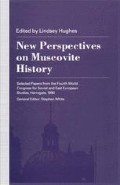Abstract
In the early 1580s north-western Russia was a scene of devastation. As the Livonian War (1558–82) came to an end, Muscovite scribes conducted surveys of the Novgorod lands, a task which had not been undertaken for almost twenty years. Their observations, compiled in cadastres or pistsovye knigi, reflect the cumulative effects of a series of catastrophic events, resulting in famine and disease, fire and flight. Some of those events had been experienced long before Muscovy’s armies began their attempt to conquer Livonia; others were direct consequences of the long, drawn-out, unsuccessful war that followed. The net effect, however, was a disaster. Entry after entry in the pistsovye knigi describes porozzhie zemli or abandoned estates that had reverted to the state’s land pool. Vast stretches of previously cultivated fields lay fallow. Some had been in this state for so long they were overgrown with brush or even forests. Whole villages sat empty; in some cases only the charred remains of peasant huts and outbuildings survived.
Access this chapter
Tax calculation will be finalised at checkout
Purchases are for personal use only
Preview
Unable to display preview. Download preview PDF.
Notes
The Novgorodian economic crisis has been discussed in scholarly literature ranging from early works, such as N. A. Ianitskii’s Ekonomicheskii krizis v Novgorodskoi oblasti XVI v. (Kiev, 1915), to the more recent product of
A. L. Shapiro, et al., Agrarnaia istoriia severo-zapada Rossii XVI veka (Leningrad, 1974). For specific discussions on the timing of the beginning of the ‘crisis’ and its causes, see Ianitskii, pp. 34–6, 101 ff, and Shapiro, pp. 293 ff.
See also, for example, A.A. Zimin, ‘“Khoziaistvennyi krizis” 60–70kh godov XVI v. i russkoe krest’ianstvo’, in Materialy po istorii sel’skogo khoziaistva i krest’ianstva SSSR, no. 5 (Moscow, 1962) pp. 11–20, and
V. I. Koretskii, ‘Khoziaistvennoe razorenie russkoi derevni vo vtoroi polovine XVI v. i pravitel’stvennaia politika’, Ezhegodnik po agrarnoi istorii vostochnoi Evropy 1965 g. (Moscow, 1970) pp. 62–70.
For a discussion of the obzha and its definition in the sixteenth century, see G. V. Abramovich, ‘Neskol’ko izyskanii iz oblasti russkoi metrologii XV-XVI vv’, in: Problemy istochnikovedeniia, vol. 11 (Moscow, 1963) pp. 376–83, and also Shapiro, pp. 10–15.
For discussions of bobyl’ occupations, see J. Blum, Lord and Peasant in Russia from the Ninth to the Nineteenth Century (Princeton, 1961; repr. New York, 1964) pp. 240–1;
G. V. Abramovich, ‘Novgorodskie pistsovye knigi kak istochnik po istorii barshchiny v pomestnom khoziaistve XVI veka’, in Ezhegodnik po agrarnoi istorii vostochnoi Evropy 1970 g. (Riga, 1977) pp. 27–8; for a survey of early literature on the subject,
see A.M. Gnevushev, Sel’skoe naselenie Novgorodskoi oblasti po pistsovym knigam 1495–1505 godov (Kiev, 1911) pp. 162 ff.
For information on human calorie requirements, see C. Clark, Population Growth and Land Use (London and New York, 1968) p. 130.
See also A. L. Shapiro, Agrarnaia istoriia severo-zapada Rossii (Leningrad 1971) pp. 49–50, 270, where an estimate of human protein requirements of 1520 puds per person per year is offered.
G. V. Abramovich, ‘Novgorodskoe pomest’e v gody ekonomicheskogo krizisa poslednei treti XVI v.’, in: Materialy po istorii sel’skogo khoziaistva i krest’ianstva SSSR, book 8 (Moscow, 1974) pp. 5–26.
On the importance of forests as supplements to agriculture, see Shapiro (1971) p. 47, and (1974) pp. 252–3; Smith, pp. 47–79; and R.A. French, ‘Russians and the Forest’, in James H. Bater and R. A. French (eds), Studies in Russian Historical Geography, 2 vols. (London and New York, 1983) pp. 25–30.
Editor information
Editors and Affiliations
Copyright information
© 1993 International Council for Soviet and East European Studies, and Lindsey Hughes
About this chapter
Cite this chapter
Martin, J. (1993). Economic Survival in the Novgorod Lands in the 1580s. In: Hughes, L. (eds) New Perspectives on Muscovite History. Palgrave Macmillan, London. https://doi.org/10.1007/978-1-349-22428-9_8
Download citation
DOI: https://doi.org/10.1007/978-1-349-22428-9_8
Publisher Name: Palgrave Macmillan, London
Print ISBN: 978-1-349-22430-2
Online ISBN: 978-1-349-22428-9
eBook Packages: Palgrave History CollectionHistory (R0)

